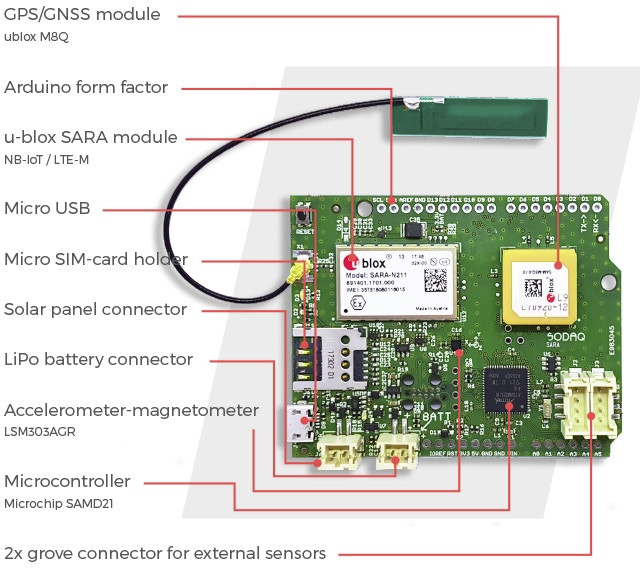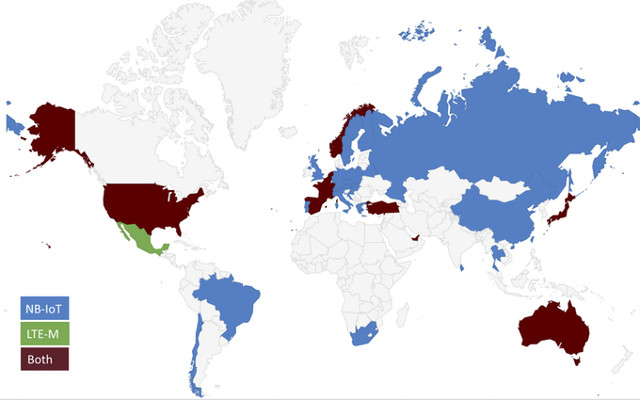There really seems to be a push for cellular IoT those days, with new hardware coming up every week. Following up on their NB-IoT shield for Arduino last year, SODAQ has now launched two versions of SARA boards based on u-blox SARA LTE-IoT modules, and u-blox M8Q GPS/GNSS module.
Both boards are Arduino compatible thanks to a Microchip SAMD21 MCU, and while u-blox SARA board follows the Arduino form factor, u-box SARA SFF is much more compact (50×25.4 mm) and potentially easier to integrate into a project or product. Another pretty unique feature (AFAICT) is that you can power the board directly with a solar panel.
 u-blox SARA board specifications:
u-blox SARA board specifications:
- Wireless module (three options) with external antenna:
- SARA-N211 NB-IoT, band 8 and 20, for the European and African market
- SARA-R410M Dual mode LTE-M and NB-IoT module for all global bands
- SARA-R412M Triple mode module with LTE-M, NB-IoT and 2G for all global bands
- Micro SIM card sholder
- Location Module – u-blox SAM-M8Q with support for GPS, Galileo, GLONASS
- MCU – Microchip SAMD21 Arm Cortex-M0+ CPU running at up to 48MHz
- Sensor – STMicro LSM303AGR accelerometer and magnetometer
- Expansion – 2x Grove connectors for external sensors, unpopulated Arduino headers
- Power Supply
- 5V via micro USB port
- LiPo battery connector
- Solar panel connector
- Dimensions – Arduino form factor

Somehow the company managed to pack most of the features of SODAQ SARA in their Small Form Factor (SFF) version, except they replaced the GNSS module with a smaller one (unnamed) and used an u.FL connector for an external GNSS antenna. At 50×25.4mm the board is said to be small enough to fit into a matchbox.
With three different LTE IoT module and two form factors, there are 6 different versions of the board:
- SARA-N211 NB-IoT (Band 8/20) for 90 Euros
- SARA-R410M NB-IoT + LTE Cat M for 100 Euros
- SARA-R412M NB-IoT + LTE Cat M + 2G fallback for 110 Euros with 1,200 mAh battery
- SFF N211 for 95 Euros
- SFF R410M for 105 Euros
- SFF R412M for 115 Euros with 800 mAh battery
To select the best board for your need, the map below showing NB-IoT / eMTC coverage may help.
 The map above is good for reference only, as for example while NB-IoT has been deployed in Thailand (highlighted in blue), there are only a few base stations support NB-IoT at this stage, so the LTE-IoT network is not available countrywide. You may want to check GSMA website for more details info about eMTC/NB-IoT deployments including the name of providers in each country.
The map above is good for reference only, as for example while NB-IoT has been deployed in Thailand (highlighted in blue), there are only a few base stations support NB-IoT at this stage, so the LTE-IoT network is not available countrywide. You may want to check GSMA website for more details info about eMTC/NB-IoT deployments including the name of providers in each country.
The company launched a Kickstarter campaign to fund mass production aiming to raise 25,000 Euros (about $30,700 US). Shipping adds 10 Euros to European countries, and 20 Euros to the rest of the world, and delivery is planned for March to June 2018 depending on reward.

Jean-Luc started CNX Software in 2010 as a part-time endeavor, before quitting his job as a software engineering manager, and starting to write daily news, and reviews full time later in 2011.
Support CNX Software! Donate via cryptocurrencies, become a Patron on Patreon, or purchase goods on Amazon or Aliexpress




